Living with Hearing Loss
First Deaf-Blind Person to Earn a BA: A Remarkable Journey
Astonishing journey of the first deaf-blind person to earn a BA reveals an inspiring tale of resilience and determination that will leave you in awe.
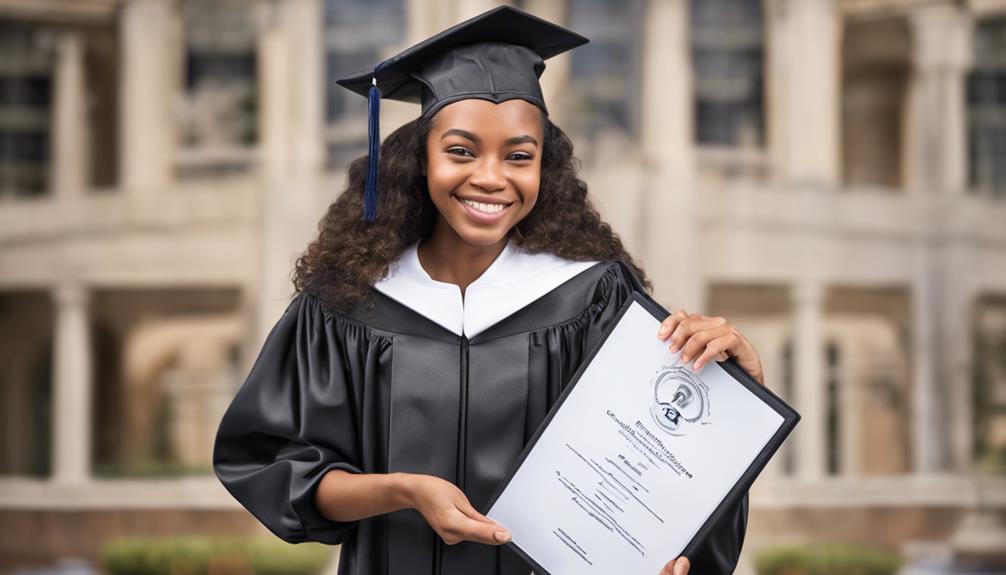
As we consider the remarkable journey of the first deaf-blind person to earn a Bachelor of Arts degree, it's fascinating to note that Helen Keller's groundbreaking achievement at Radcliffe College in 1904 paved the way for countless individuals facing similar challenges.
The hurdles she overcame and the milestones she reached serve as a testament to human resilience and the power of unwavering determination.
Keller's story is not just one of personal triumph but also a beacon of hope and inspiration for all who strive to overcome adversity and achieve their dreams.
Key Takeaways
- Helen Keller overcame deaf-blindness to become the first to earn a BA, inspiring advancements in disability rights.
- Innovative communication methods and family support were pivotal in Keller's academic success.
- Accessible education tools like Braille and tactile signing are essential for deaf-blind individuals.
- Keller's advocacy extended beyond disabilities to women's suffrage, labor rights, and pacifism.
Early Life and Challenges Faced
In the early stages of her life, Helen Keller encountered profound challenges due to losing her sight and hearing at just 19 months old. Being both deaf and blind presented unique obstacles in communication and learning for Keller. These challenges could have easily deterred her progress, but Keller's early resilience shone through as she started speaking at an incredibly young age of 6 months and walking by 1 year old, showcasing her determination to overcome adversity.
Anne Sullivan, Keller's devoted teacher, played a pivotal role in introducing her to innovative communication methods, such as finger spelling. Sullivan's dedication and patience opened up a whole new world for Keller, enabling her to break through the barriers of her disabilities.
Despite the hardships she faced, Keller's indomitable spirit propelled her forward. Her journey from the Horace Mann School for the Deaf to graduating cum laude from Radcliffe College in 1904 is a testament to her unwavering perseverance and the transformative power of effective communication methods.
Family Support and Encouragement
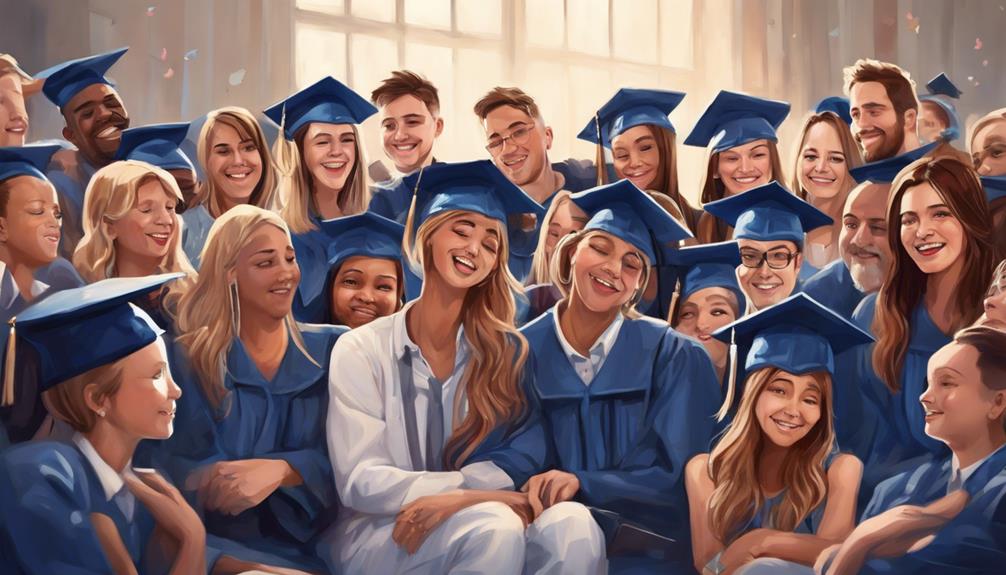
Receiving unwavering support and encouragement from her family, particularly her parents, Arthur H. Keller and Katherine Adams Keller, was pivotal in Helen Keller's remarkable journey as the first deaf-blind person to earn a Bachelor of Arts degree. Keller's family provided not only emotional backing but also financial stability derived from a cotton plantation, granting her access to essential educational resources. Growing up in a nurturing environment, despite her disabilities, enabled Keller to flourish. Her family played a crucial role in facilitating her communication and learning processes from a young age, setting the stage for her future academic achievements.
| Family Support and Encouragement |
|---|
| Financial Stability |
| Nurturing Environment |
| Communication |
| Learning Processes |
| Academic Achievements |
Education and Learning Strategies
As we explore education and learning strategies for individuals with sensory impairments, it's crucial to highlight the significance of learning tools tailored for the deaf-blind community.
These tools, such as Braille and tactile sign language, play a vital role in enabling access to education and fostering effective communication.
Learning Tools for Deaf-Blind
Utilizing tactile sign language, Braille, and adaptive technology serves as crucial aids for deaf-blind individuals in accessing educational opportunities. Deaf-blind students often rely on tactile signing, where signs are felt on their hands, to communicate with teachers and peers effectively. Tactile graphics, like raised-line drawings, play a vital role in helping these students comprehend visual information such as maps and diagrams. Individualized education plans (IEPs) tailored to each student's unique needs are essential, encompassing specialized instruction, communication methods, and support services. Educators undergo specific training to facilitate tactile communication, implement assistive technology, and create inclusive learning environments. This comprehensive approach ensures that deaf-blind students receive the necessary tools and support to thrive academically.
| Learning Tools | Description | Importance |
|---|---|---|
| Tactile Sign Language | Communication via touch on hands | Facilitates effective interaction |
| Braille | System of raised dots for reading and writing | Enables access to written materials |
| Adaptive Technology | Tools like screen readers and magnifiers | Enhances digital accessibility |
| Tactile Graphics | Raised-line drawings for visual information | Aids in understanding maps and diagrams |
Adapted Curriculum Approaches
Our exploration now shifts to examining how adapted curriculum approaches in education and learning strategies have positively impacted individuals like Helen Keller, emphasizing hands-on learning and individualized instruction tailored to unique needs. Helen Keller's education journey was shaped by specialized techniques in tactile signing and manual communication, utilizing tactile sign language and Braille.
Her learning process involved adapted materials in Braille and raised print, allowing access to educational content. Additionally, Keller benefited from the use of physical objects, models, and real-life experiences, enhancing her sensory experiences and overall comprehension. The guidance of Anne Sullivan played a crucial role in delivering individualized instruction, highlighting the importance of personalized approaches in education for individuals with unique needs.
- Utilization of tactile sign language and Braille
- Emphasis on hands-on learning
- Provision of individualized instruction
- Access to adapted materials
- Enhancement of sensory experiences through real-life learning
Overcoming Communication Barriers

We can appreciate the significance of sign language communication and Braille literacy development in breaking down communication barriers for individuals with deaf-blindness. These tools not only enable expression but also foster understanding and connection with others.
Sign Language Communication
Sign language, with its tactile and visual components, served as a vital tool in overcoming communication barriers for Helen Keller, the first deaf-blind person to earn a BA. Keller's use of sign language with her teacher, Anne Sullivan, facilitated their unique form of communication, enabling her to express thoughts and engage with the world.
Through finger spelling and tactile sign language, Keller mastered this unique form of communication, which played a crucial role in her educational journey and intellectual development. Sign language empowered Keller to learn new concepts, express herself, and break through the isolation imposed by her disabilities. It was through sign language that Keller found a way to connect with others and navigate the world around her effectively.
- Sign language facilitated unique communication with Anne Sullivan.
- Finger spelling helped Keller express her thoughts.
- Tactile sign language enabled Keller to engage with the world.
- Sign language played a crucial role in Keller's educational journey.
- Keller used sign language to overcome isolation and connect with others.
Braille Literacy Development
Learning Braille was a transformative milestone for Helen Keller, unlocking a world of literacy and communication previously hindered by her deaf-blindness. Braille literacy development not only enabled Keller to access information and communicate effectively but also empowered her to advocate for individuals with disabilities. Through her mastery of Braille, Keller achieved academic milestones, culminating in a Bachelor of Arts degree from Radcliffe College. Her proficiency in Braille allowed her to express herself through writing, publishing books, articles, and delivering inspiring speeches. Keller's ability to connect with others through Braille transcended communication barriers, showcasing the power of determination in overcoming obstacles. Below is a table highlighting the significance of Braille literacy in Keller's journey:
| Braille Literacy Development |
|---|
| Empowered Communication |
| Academic Achievements |
| Advocacy |
| Overcoming Barriers |
| Inspirational Legacy |
Academic Accomplishments and Milestones

Helen Keller's historic achievement of earning a Bachelor of Arts degree in 1904 from Radcliffe College stands as a testament to her unwavering determination and academic prowess despite her deaf-blindness. Keller's graduation marked a pivotal moment in the realm of inclusive education, showcasing the power of perseverance and dedication in the face of significant challenges.
Here are five key points highlighting Keller's academic accomplishments and milestones:
- Keller became the first deaf-blind person to earn a Bachelor of Arts degree, breaking barriers and inspiring generations.
- Despite her disabilities, Keller graduated cum laude, underscoring her exceptional academic abilities and resilience.
- Keller's achievement opened doors to greater educational opportunities for the deaf-blind community, fostering a more inclusive academic landscape.
- By earning a BA, Keller exemplified the transformative impact of education in empowering individuals with disabilities.
- Keller's journey emphasizes the importance of accessible education, showcasing the remarkable outcomes that can be achieved through determination and hard work.
Pioneering Advocacy Work

As we explore the topic of pioneering advocacy work in Helen Keller's journey, we uncover the profound impact of her advocacy efforts.
Keller's trailblazing initiatives set the stage for improved rights and opportunities for the deaf-blind community.
Her dedication to advocacy continues to inspire individuals with disabilities to champion their rights and pursue their aspirations.
Advocacy Impact
Pioneering advocacy efforts by Helen Keller significantly reshaped societal perceptions and opportunities for individuals with disabilities, leaving a lasting impact on creating a more inclusive society. Keller's tireless work in advocating for disability rights and education has had a profound effect on enhancing awareness and fostering equal opportunities. Her advocacy efforts not only influenced policies and practices but also inspired a societal shift towards a more inclusive approach.
Keller's legacy continues to drive ongoing initiatives aimed at promoting equal rights and creating a more accessible environment for individuals with disabilities.
- Keller's advocacy work inspired changes in societal attitudes towards disabilities.
- Her efforts led to improvements in educational opportunities for individuals with disabilities.
- Keller's advocacy work highlighted the importance of disability awareness.
- She fought for the rights of individuals with disabilities to be recognized and respected.
- Keller's advocacy work laid the foundation for a more inclusive society.
Trailblazing Initiatives
Advocacy efforts championed by Helen Keller paved the way for trailblazing initiatives that revolutionized societal attitudes towards disabilities and fostered a more inclusive environment for individuals with diverse needs. Keller's groundbreaking achievement at Radcliffe College in 1904 showcased the potential of individuals with disabilities to excel academically, opening doors to greater educational opportunities. Her journey highlighted the values of perseverance, determination, and the crucial role of support in overcoming challenges. By earning her BA degree, Keller not only demonstrated her own capabilities but also challenged stereotypes and inspired a shift towards more inclusive practices. Keller's legacy continues to inspire efforts that promote equal access to education and empower individuals of all abilities to pursue their dreams.
| Trailblazing Initiatives | ||
|---|---|---|
| Educational Opportunities | Perseverance | Determination |
| Support | Inclusivity | Empowerment |
Personal Growth and Resilience

Helen Keller's remarkable journey to earning a Bachelor of Arts degree showcased her unwavering personal growth and resilience in the face of deafness and blindness. Keller's determination and perseverance were key factors in her academic success, allowing her to master Braille, sign language, and tactile communication methods despite her disabilities. Through dedication and hard work, she not only excelled academically but also inspired countless individuals along the way.
- Mastering Communication: Keller's ability to learn and adapt different communication methods highlighted her resilience and commitment to overcoming challenges.
- Educational Excellence: Keller's groundbreaking academic achievements as the first deaf-blind person to earn a BA underscored her unwavering determination and perseverance.
- Inspiring Others: Keller's journey inspired many, showing that with resilience and hard work, any obstacle can be overcome.
- Personal Development: Keller's growth as an individual throughout her educational journey exemplified the power of resilience in facing adversity.
- Legacy of Resilience: Keller's legacy continues to inspire individuals to embrace challenges with courage and resilience, fostering a mindset of continuous growth and learning.
Impact on Deaf-Blind Community
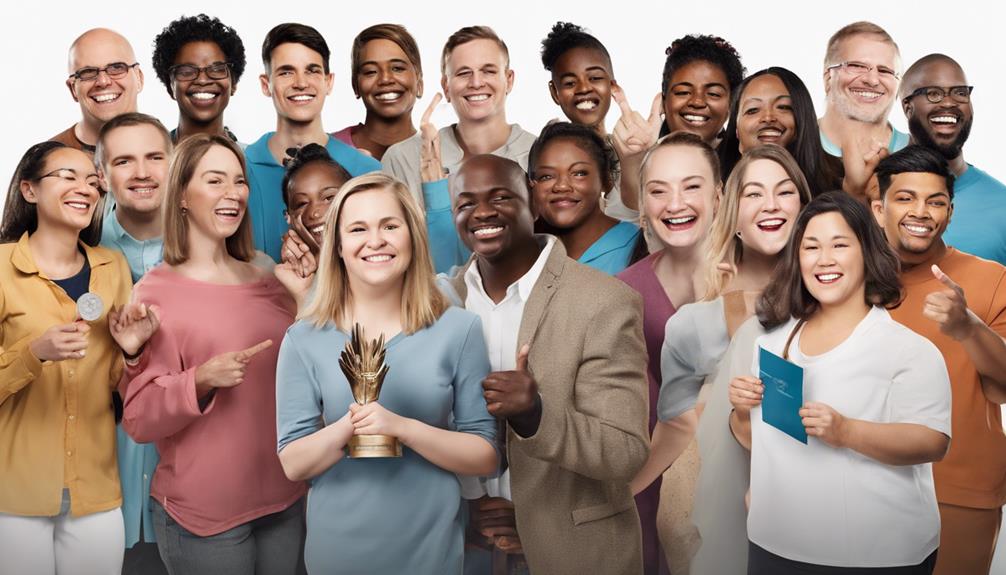
The impact of Helen Keller's educational achievements on the deaf-blind community has been profound and far-reaching. Keller's groundbreaking success as the first deaf-blind person to earn a Bachelor of Arts degree has inspired individuals within the deaf-blind community worldwide. Her journey exemplifies the power of perseverance, highlighting the importance of determination in overcoming obstacles. By showcasing the capabilities and potential of deaf-blind individuals in higher education, Keller's achievements have paved the way for greater inclusivity and recognition for this community.
Through Keller's academic accomplishments, a spotlight has been cast on the need for equal educational opportunities for all, emphasizing the importance of creating an environment where individuals with disabilities, including those who are deaf-blind, can thrive and succeed. Keller's journey serves as a beacon of hope and encouragement, reminding us all of the incredible achievements that can be reached through dedication and resilience. Her legacy continues to inspire future generations to pursue their educational goals and push boundaries in the face of adversity.
Inspirational Journey to Graduation

As we reflect on the inspirational journey to graduation, we recognize the power of overcoming challenges together.
It's through the strength of our support systems that we navigate the hurdles towards academic success.
Let's celebrate the resilience and determination that pave the way for achieving remarkable milestones.
Overcoming Challenges Together
In our collective journey towards graduation, the bond between a determined student and a dedicated teacher illuminated the path to overcoming seemingly insurmountable challenges. Helen Keller and Anne Sullivan's story exemplifies the power of perseverance, mentorship, teamwork, and determination in conquering disabilities and achieving graduation. Together, they showcased:
- The transformative impact of dedicated support and education.
- Innovative teaching methods that broke barriers.
- The importance of collaborative effort in achieving milestones.
- A testament to resilience and determination in the face of adversity.
- The incredible results of unwavering dedication and belief in one another.
Their inspirational journey serves as a beacon of hope and a reminder of the remarkable achievements possible through shared determination and support.
Support System Strengthens
Navigating the challenging path to graduation, a robust support system fortified Helen Keller's inspirational journey towards becoming the first deaf-blind person to earn a Bachelor of Arts degree. Anne Sullivan's mentorship and innovative teaching methods were instrumental in helping Keller develop effective communication skills and overcome the unique challenges she faced.
Keller's perseverance and the unwavering teamwork between her and Sullivan exemplified the strength that can arise from a supportive partnership. Together, they demonstrated the power of resilience in the face of adversity, inspiring others to pursue their educational aspirations despite obstacles.
Keller's remarkable achievement highlighted the importance of a strong support system, determination, and self-belief in achieving academic success against all odds.
Academic Success Celebrated
Celebrating Helen Keller's remarkable journey to graduation as the first deaf-blind person to earn a Bachelor of Arts degree showcases unparalleled perseverance and dedication to academic excellence. Keller's academic success at Radcliffe College in 1904 was a testament to her unwavering commitment to learning, inspiring inclusivity and breaking barriers for the deaf-blind community. Her graduation with honors not only highlighted the power of education but also emphasized the importance of equal access to educational resources for all individuals. Keller's story serves as a beacon of hope, proving that with resilience and determination, extraordinary accomplishments are within reach for everyone.
- Keller's graduation with honors symbolized triumph over adversity.
- Her academic achievements challenged societal perceptions of disabilities.
- Keller's journey emphasized the significance of perseverance in education.
- The inclusivity she championed paved the way for future generations.
- Keller's legacy continues to inspire individuals to overcome obstacles and strive for success.
Celebrating the BA Achievement

With Keller's groundbreaking achievement, a beacon of inspiration illuminates the path for those facing similar challenges in pursuit of higher education. Helen Keller's attainment of a BA degree from Radcliffe College in 1904 stands as a testament to the unwavering power of determination, resilience, and the transformative impact of education, especially for individuals with disabilities. Keller's journey not only shattered barriers but also emphasized the vital role education plays in empowering individuals to reach their full potential.
Her BA degree not only symbolized academic success but also served as a catalyst for her to become an influential author, activist, and advocate for the deaf-blind community. Keller's triumph continues to echo through time, reminding us of the importance of perseverance and the boundless possibilities that education can offer, regardless of the obstacles one may face. The celebration of Keller's BA achievement fuels the flames of ambition in all individuals striving to overcome adversity and achieve their educational aspirations.
Recognition and Media Attention

Amidst the spotlight of media attention, Helen Keller's groundbreaking achievement as the first deaf-blind person to earn a Bachelor of Arts degree from Radcliffe College in 1904 resonated globally, showcasing unparalleled perseverance and determination. Keller's graduation with honors garnered widespread recognition and admiration, shedding light on the capabilities of individuals with disabilities and inspiring a wave of inclusivity and support.
The media attention surrounding Keller's academic feat not only celebrated her personal triumph but also symbolized a significant step towards breaking down barriers for the deaf-blind community. Here are five aspects that underline the impact of Helen Keller's graduation on society:
- Keller's journey exemplified the transformative power of education and determination in overcoming seemingly insurmountable challenges.
- The media coverage of Keller's graduation brought awareness to the struggles and successes of deaf-blind individuals, fostering a more understanding and inclusive society.
- Keller's achievement highlighted the importance of providing equal opportunities and support for individuals with disabilities in academic settings.
- The global recognition of Keller's milestone paved the way for increased advocacy and resources for the deaf-blind community.
- Keller's story continues to inspire future generations to pursue their aspirations with resilience and unwavering dedication.
Future Goals and Aspirations

Helen Keller's groundbreaking achievement as the first deaf-blind person to earn a Bachelor of Arts degree from Radcliffe College in 1904 paved the way for her future goals and aspirations centered around advocating for disability rights and education for the deaf-blind community.
Keller's vision extended beyond personal success, aiming to raise awareness about the challenges faced by individuals with disabilities. She aspired to inspire others to overcome obstacles and achieve their goals, regardless of their circumstances.
In her quest for inclusivity, Keller sought to promote equal opportunities for all, irrespective of disabilities, through continued activism, writing, and speaking engagements. Her dedication to advocating for disability rights and education for the deaf-blind community remains a beacon of inspiration, urging us to push boundaries, challenge norms, and foster a more inclusive society.
Through her tireless efforts, Keller set a precedent for future generations to embrace activism and strive for positive change in the world.
Lessons Learned and Takeaways

In reflecting on Helen Keller's remarkable journey, one can't help but draw valuable lessons and meaningful takeaways that resonate deeply with the human spirit. Keller's historic achievement at Radcliffe College stands as a testament to the power of determination, perseverance, and education in the face of adversity. Through her inspirational story, we glean insights that transcend time and circumstance, offering guidance and encouragement to all who face challenges on their paths to success.
- Mentorship: Keller's relationship with Anne Sullivan underscores the transformative impact of mentorship in unlocking one's full potential.
- Determination: Keller's unwavering resolve to pursue her education despite profound sensory limitations teaches us the importance of staying committed to our goals.
- Education: Keller's thirst for knowledge and continuous learning exemplifies how education can empower individuals to break barriers and achieve greatness.
- Perseverance: Keller's resilience in the face of immense obstacles serves as a beacon of hope for those navigating their own struggles.
- Inspiration: Keller's groundbreaking accomplishment continues to inspire generations, reminding us that with courage and perseverance, anything is possible.
Legacy and Continued Influence
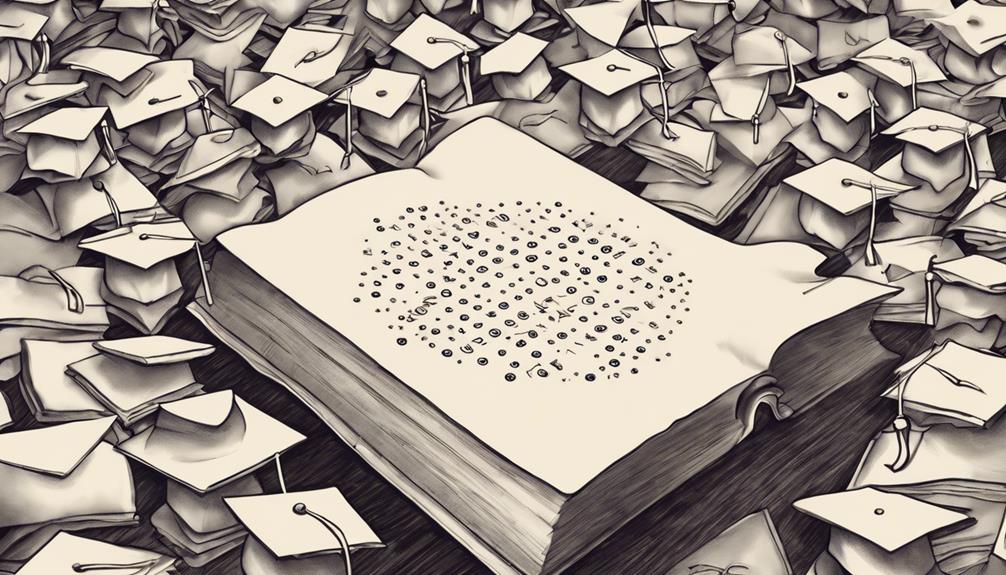
With a profound impact that reverberates through time, Helen Keller's enduring legacy as the first deaf-blind person to earn a Bachelor of Arts degree continues to inspire individuals facing challenges. Keller's journey exemplifies the power of perseverance and determination in overcoming barriers, emphasizing the importance of inclusive education and equal opportunities for individuals with disabilities. By breaking boundaries, she opened doors for the deaf-blind community, paving the way for enhanced educational prospects.
| Legacy | Influence |
|---|---|
| Perseverance | Inspiring others |
| Determination | Breaking barriers |
| Inclusive education | Equal opportunities |
| Overcoming obstacles | Shaping future |
Keller's legacy serves as a beacon of hope, reminding us of the transformative impact of resilience and the necessity of creating a more inclusive society. Her influence continues to shape perceptions, encouraging individuals to strive for academic and personal success despite adversities. Through Keller's remarkable accomplishments, the world learns that with determination and support, any obstacle can be overcome.
Frequently Asked Questions
Who Was the First Deaf-Blind Person to Earn a Ba?
We believe the first deaf-blind person to earn a BA was Helen Keller, who graduated cum laude from Radcliffe College in 1904. Her remarkable journey inspires individuals worldwide.
Keller's achievement emphasizes the importance of accessibility and support for those with sensory impairments pursuing higher education.
Her success opened doors for greater opportunities and inclusivity in the education system for deaf-blind individuals.
Who Was the First Deaf-Blind Person to Graduate?
We're the first deaf-blind person to graduate. It's a groundbreaking achievement, showcasing the power of perseverance and determination in the face of adversity. Our journey inspires individuals worldwide, highlighting the importance of inclusive education.
Who Was Famous for Being Blind and Deaf?
We all know Helen Keller was famous for being blind and deaf. Her remarkable journey of resilience and determination inspired many. Despite her disabilities, Keller's educational achievements showcased the power of perseverance.
Graduating with honors from Radcliffe College, she became the first deaf-blind person to earn a Bachelor of Arts degree. Keller's accomplishments marked a significant milestone in the history of individuals with disabilities, highlighting the importance of determination and overcoming obstacles.
Who Is the American Author the First Deaf-Blind Person to Earn a Bachelor's Degree and Published an Autobiography the Story of My Life at the Age of 22?
We're talking about Helen Keller, the incredible American author who, at 22, became the first deaf-blind person to earn a Bachelor's degree and wrote the autobiography 'The Story of My Life.'
It's truly inspiring how Keller's determination and resilience paved the way for so many. Her story is a testament to the power of overcoming challenges and the importance of inclusivity for all.
Helen Keller's legacy continues to inspire and educate us today.
How Did the First Deaf-Blind Person Overcome Challenges to Earn a BA and Can Deaf Students Find Part-Time Jobs?
Helen Keller, the first deaf-blind person to earn a BA, overcame immense challenges through resilience and determination. Deaf students can find comprehensive part-time job options with companies that value diversity and provide accommodations for individuals with disabilities.
Conclusion
In conclusion, Helen Keller's journey as the first deaf-blind person to earn a Bachelor of Arts degree is like a beacon of light shining through the darkness, illuminating the path of determination and resilience.
Her legacy serves as a reminder that with perseverance and support, any obstacle can be overcome.
Keller's story continues to inspire us to strive for greatness and advocate for inclusivity and equal opportunities for all.
Jamie is one of the creative forces behind the words that resonate with our audience at Deaf Vibes. With a passion for storytelling and advocacy, Jamie delves into topics that matter deeply to the deaf and hard-of-hearing community. Jamie’s articles are crafted with empathy, insight, and a commitment to positive change, from exploring the latest advancements in hearing technologies to shedding light on the everyday challenges and victories of those within the community. Jamie believes in the power of shared stories to inspire action, foster understanding, and create a more inclusive world for everyone.
Living with Hearing Loss
How Kirkland Makes Hearing Aids: A Guide
Yearning to discover the secrets behind Kirkland's exceptional hearing aids?

As we explore the intricate process of how Kirkland makes hearing aids, it's fascinating to witness the blend of technology and craftsmanship that goes into creating these devices.
From the initial design stages to the final quality assurance checks, every step in the production journey contributes to the exceptional performance and comfort of the Kirkland Signature 10.0t model.
But what really sets these hearing aids apart? Stay tuned to uncover the secrets behind the precision manufacturing processes and advanced technology that make Kirkland hearing aids a top choice for users seeking optimal hearing solutions.
Key Takeaways
- Collaborate with Sonova for prototype design, focusing on functionality and user experience.
- Choose premium materials and quality components for durability and optimal performance.
- Utilize precision manufacturing and automation for consistent quality and efficiency.
- Prioritize customization, user experience, and support for tailored hearing aid solutions.
Designing the Hearing Aid Prototype
Collaborating with Sonova, we meticulously design and develop the prototype for Kirkland's hearing aids, ensuring they undergo rigorous testing for performance, comfort, and durability. When creating the prototype, various design elements such as size, shape, and color are carefully considered to meet the diverse needs of our customers. We also integrate advanced technologies like Bluetooth connectivity and tap control into the prototype to enhance the overall user experience.
During the design phase, our team focuses on not only the functionality of the hearing aids but also on the aesthetic appeal and ergonomic design. By incorporating feedback from focus groups and experts, we can refine the prototype further before moving into mass production. This iterative process allows us to fine-tune every aspect of the hearing aid, ensuring that it meets the highest standards of quality and performance. At Kirkland, we're dedicated to creating hearing aids that not only improve the quality of life for our customers but also exceed their expectations in terms of design and functionality.
Selecting High-Quality Materials

Selecting premium-grade materials is a crucial step in ensuring the durability and comfort of Kirkland's hearing aids. When it comes to combating hearing loss, the quality of the components used in our devices plays a significant role in delivering optimal performance.
Kirkland meticulously chooses high-quality plastics and metals, akin to selecting prime real estate, to construct durable and comfortable hearing aids that users can rely on. Moreover, sourcing top-notch microphones and speakers is paramount in guaranteeing clear sound reception and transmission, enhancing the overall auditory experience for our customers.
Precision Manufacturing Processes
At Kirkland, our precision manufacturing processes utilize state-of-the-art automated assembly systems to ensure consistent quality and efficiency. These systems allow us to meticulously craft each component of our hearing aids with precision and accuracy.
Our stringent quality control measures are integrated at every step to guarantee that each device meets our high standards for durability and performance.
Automated Assembly Systems
Utilizing advanced automated assembly systems, Kirkland ensures precision in manufacturing their hearing aids to maintain consistent quality standards. These systems are a good thing for us as they allow for intricate details to be accurately put together, ensuring that wearers can hear the sound with clarity.
By incorporating robotics and specialized machinery, Kirkland can reduce the margin of error, leading to higher efficiency during production. The automated assembly process streamlines manufacturing, enabling tight tolerances to be achieved in assembling the hearing aid components.
This level of accuracy in production is crucial for the optimal performance of the hearing aids, ensuring that each device meets the high-quality standards expected by Kirkland's customers.
Quality Control Measures
In maintaining our commitment to excellence in manufacturing, Kirkland upholds stringent quality control measures throughout the production process to ensure the precision and reliability of each hearing aid.
Our rigorous checks at every stage, coupled with advanced technologies and specialized equipment, guarantee consistent quality standards. Each component undergoes meticulous crafting and testing to meet strict specifications and performance requirements.
Thorough inspections, calibration tests, and adherence to industry regulations are integral parts of our quality control measures, ensuring optimal functionality. Kirkland's dedication to precision manufacturing processes results in hearing aids that aren't only reliable and durable but also provide exceptional sound quality and performance, meeting the highest standards of our customers' expectations.
Incorporating Advanced Technology

We integrate cutting-edge technology, such as Bluetooth Classic and tap control, into Kirkland hearing aids to enhance user experience.
Motion sensors are utilized to improve interaction and functionality, while integrated Roger receivers help in background noise reduction for clearer speech.
Our aids also support Bluetooth streaming, allowing for hands-free calls and wireless audio connectivity.
Cutting-Edge Tech Integration
Our approach to incorporating cutting-edge technology in Kirkland Signature hearing aids sets a new standard in enhancing user experience and adaptability. By integrating features like Bluetooth connectivity, users can seamlessly pair their devices with our aids for a more connected experience.
The inclusion of motion sensors further enhances adaptability, adjusting settings based on movement for optimal performance. Additionally, the integration of Roger receivers improves speech understanding in noisy environments, ensuring clear communication in various situations.
Our use of telecoil technology enables better hearing in venues equipped with loop systems, providing amplified sound directly to the aids. Moreover, the EasyLine Remote App empowers users to personalize settings easily, offering a tailored hearing solution at their fingertips.
Innovation in Production
Utilizing cutting-edge techniques such as 3D printing and laser cutting, Kirkland incorporates advanced technology in the production of their hearing aids to ensure precision and innovation.
The incorporation of AI algorithms guarantees precise customization and fitting for each user, while automated assembly lines streamline manufacturing for efficiency.
Quality control measures, including rigorous testing and inspection, ensure the reliability and performance of each hearing aid.
Continuous research and development efforts further drive innovation in Kirkland's production processes, allowing them to meet the evolving needs of consumers efficiently.
Assembling the Internal Components
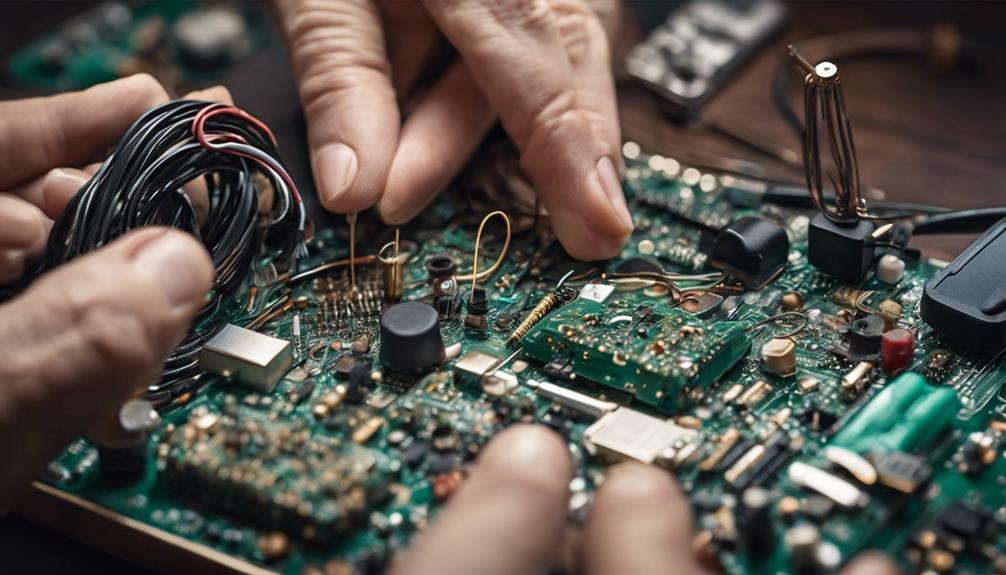
When assembling the internal components of Kirkland hearing aids, skilled technicians meticulously place the microphones, processors, and speakers into the housing with precision. Each component is carefully positioned to ensure seamless integration and optimal functionality. The microphones, responsible for capturing sounds, are strategically located to capture a wide range of frequencies effectively.
Processors, the brains of the hearing aid, are intricately placed to process and enhance the incoming sound signals. Speakers, crucial for delivering amplified sounds to the wearer, are delicately installed to provide clear and natural sound quality.
Precision is paramount during this process to guarantee that all components work harmoniously together, amplifying sounds and ultimately improving the wearer's hearing experience. By sourcing high-quality internal components from trusted manufacturers and utilizing the expertise of skilled technicians, Kirkland ensures that each hearing aid meets rigorous standards for performance and durability. This meticulous assembly process sets the foundation for the functionality and quality of the final product.
Testing for Functionality and Quality
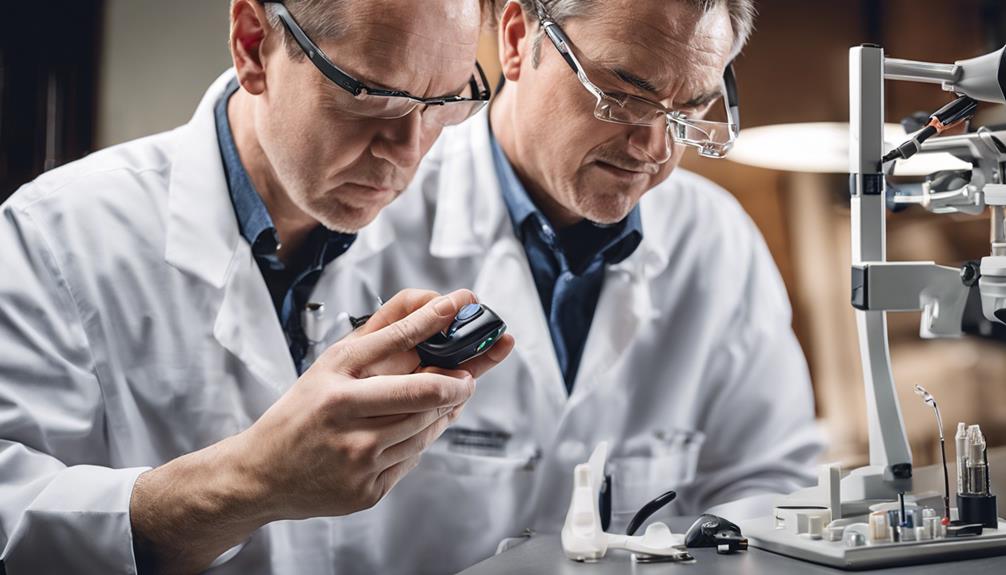
Conducting meticulous and comprehensive functional tests is a critical step in ensuring the quality and reliability of Kirkland hearing aids. Our dedication to delivering top-notch products is evident in the rigorous testing procedures each device undergoes. Here's how we ensure that every Kirkland hearing aid meets our high standards:
- Sound Clarity Testing:
Each hearing aid is meticulously tested to guarantee optimal sound clarity across different frequencies.
- Volume Adjustments:
We check and recheck the volume adjustments to ensure smooth transitions and accurate levels.
- Program Changes:
Testing includes verifying the effectiveness of different programs and the seamless transition between them.
- Connectivity Features:
The functionality of connectivity features such as Bluetooth and wireless capabilities is thoroughly tested to provide a seamless user experience.
Fine-Tuning Sound Performance
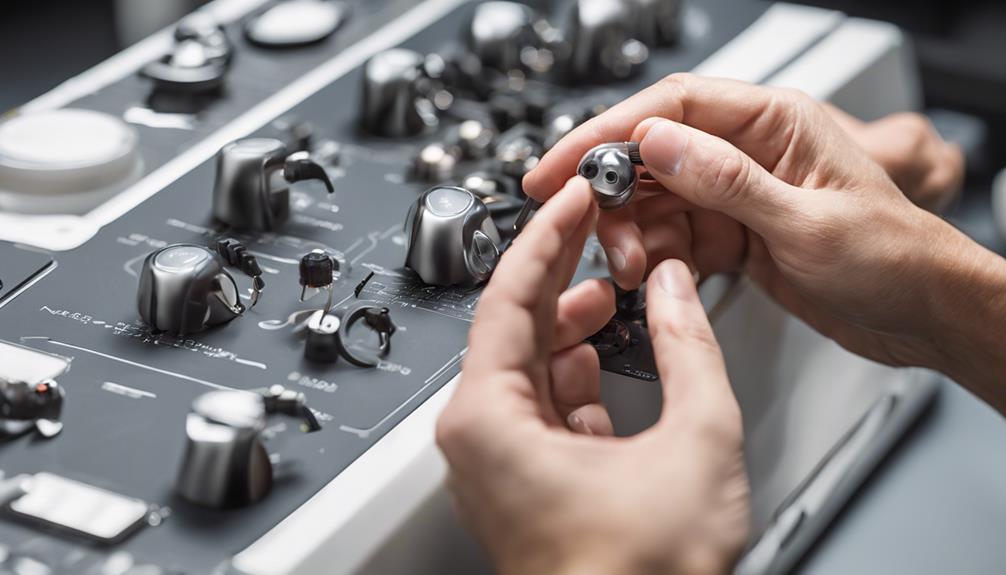
To ensure optimal sound performance tailored to individual needs, Kirkland meticulously fine-tunes the frequency response of each hearing aid. This process involves adjusting the frequency response to match the specific hearing requirements of the wearer. By customizing the sound profile, Kirkland ensures that users receive the best possible listening experience. Additionally, speech enhancement settings can be personalized to improve clarity during conversations in noisy environments. Compression settings are also fine-tuned to enhance comfort and speech understanding. Furthermore, feedback management systems are employed to eliminate whistling and enhance overall sound quality. Real ear measurements play a crucial role in this fine-tuning process, ensuring that the hearing aids provide accurate amplification tailored to the user's unique ear shape and size.
| Fine-Tuning Sound Performance | |
|---|---|
| Adjusting Frequency Response | Customizing Sound Profile |
| Personalizing Speech Settings | Enhancing Comfort and Clarity |
| Utilizing Feedback Management | Ensuring Accurate Amplification |
Customizing for Individual Needs
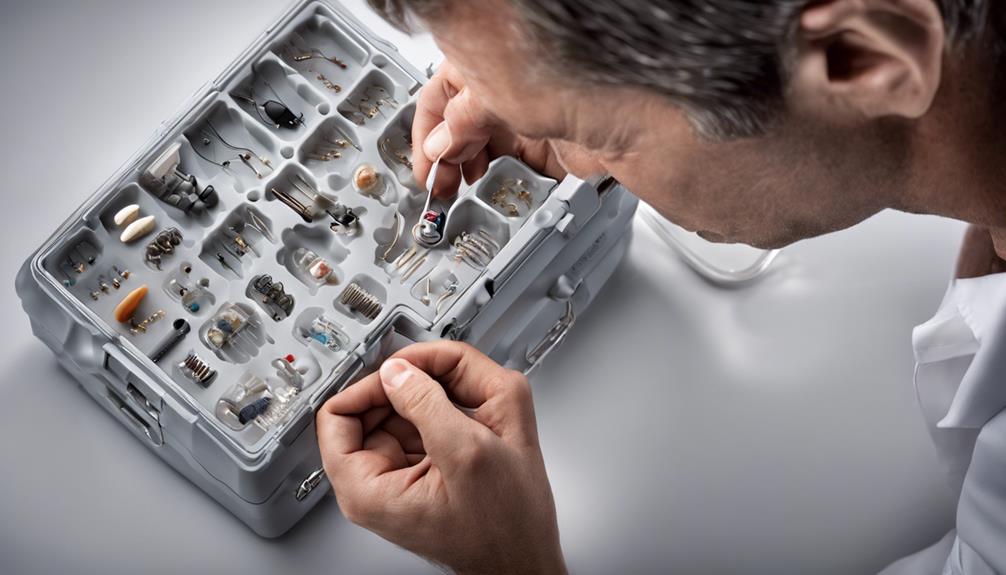
In our meticulous process of customizing hearing aids for individual needs, Kirkland carefully adjusts settings such as volume, noise reduction, and speech enhancement to meet specific hearing requirements. Here's how we tailor each hearing aid to suit the unique needs of our customers:
- Personalized Fitting Options: We offer customized fitting options to enhance comfort and sound quality based on individual ear anatomy and preferences.
- Fine-Tuning Frequency Response: Our experts fine-tune the frequency response to address distinct hearing loss patterns, ultimately improving speech clarity for users.
- Real-Ear Measurement: Kirkland's professional audiologists utilize real-ear measurement techniques to ensure precise customization for each individual, guaranteeing optimal performance.
- Enhanced User Satisfaction: Individual customization not only improves speech understanding but also boosts overall hearing aid performance, leading to heightened user satisfaction.
Through these personalized adjustments, we strive to provide our customers with hearing aids that cater specifically to their unique hearing needs, enhancing their overall auditory experience.
Packaging and Quality Assurance
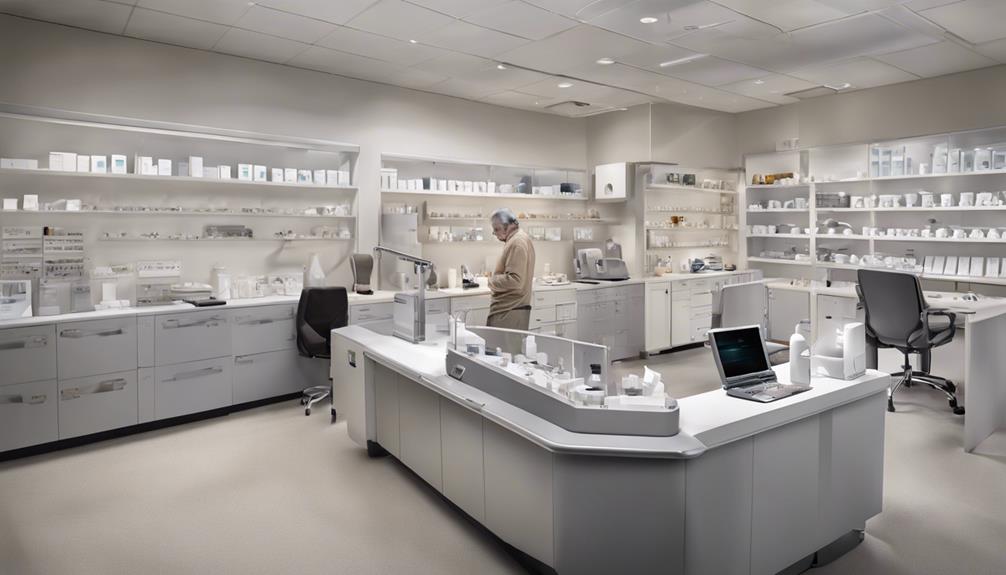
During our meticulous process of preparing Kirkland hearing aids for distribution, we focus on packaging and quality assurance to ensure the highest standards of functionality and user satisfaction. Each Kirkland hearing aid undergoes rigorous quality assurance testing to guarantee optimal performance. Our dedicated team meticulously inspects every device to ensure it meets our stringent functionality and performance standards before being carefully packaged.
The packaging includes protective cases, charging accessories, and user manuals to provide convenience and ease of use for our customers. Quality control measures are implemented at every stage to ensure that only fully functional hearing aids reach the end-user, reflecting our commitment to delivering top-notch products. The packaging design is user-friendly, featuring clear instructions for setup and maintenance, enhancing the overall user experience.
At Kirkland, we prioritize quality assurance and packaging to uphold our reputation for excellence in providing reliable hearing solutions.
Distribution and Customer Support
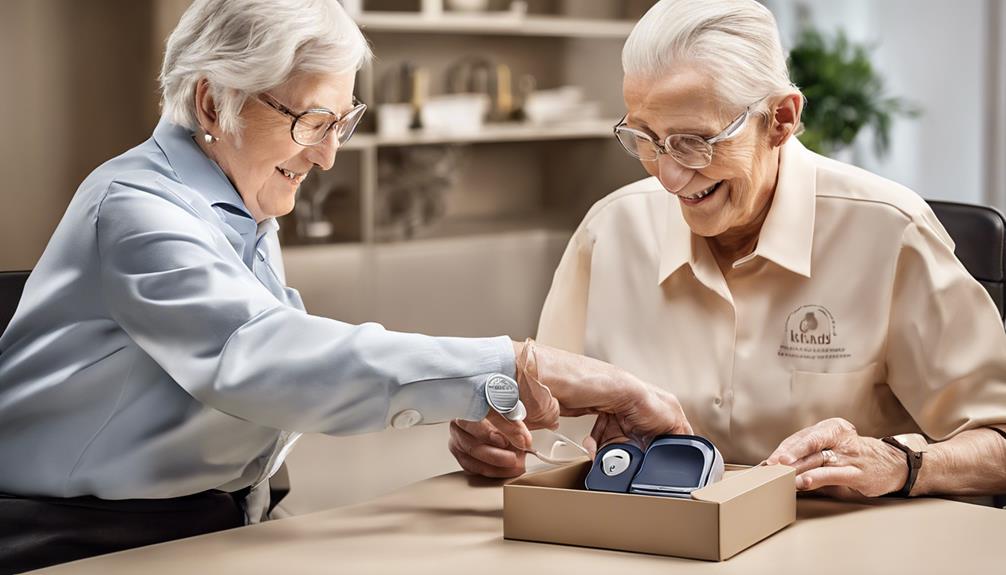
At Kirkland, we prioritize providing excellent customer support through our widespread service centers, ensuring accessibility for those seeking assistance with their hearing aids.
Our warranty coverage details offer peace of mind to customers, guaranteeing quality and reliability in our products.
Additionally, online support options further enhance the customer experience, offering convenience and quick solutions for any inquiries or issues that may arise.
Service Centers Availability
Within select Costco warehouses across the United States, customers can access Kirkland hearing aids exclusively at Costco Hearing Aid Centers, which provide a range of professional services and customer support for users.
- Professional Services: Costco Hearing Aid Centers offer comprehensive services including hearing tests, fittings, adjustments, and follow-up care.
- Dedicated Support Team: Customers have access to a team of audiologists and hearing aid specialists for assistance with questions, troubleshooting, and maintenance.
- Transparent Pricing: Costco's pricing model ensures cost-effective options compared to traditional retailers.
- Convenient Availability: With extended hours and flexible appointment scheduling, Costco Hearing Aid Centers cater to customers' busy schedules.
Costco's commitment to quality service and support ensures a seamless experience for Kirkland hearing aid users.
Warranty Coverage Details
We ensure comprehensive warranty coverage details for distribution and customer support of Kirkland hearing aids from Costco. Our hearing aids typically come with a 3-year warranty that covers repairs and services provided by Costco's hearing aid centers. This warranty ensures that customers can access necessary services at any Costco warehouse offering hearing aid support.
By guaranteeing reliable distribution and customer support, we aim to enhance user satisfaction and demonstrate our commitment to quality. The warranty coverage details for Kirkland hearing aids highlight Costco's dedication to providing excellent support for our valued customers.
Rest assured, we stand by our products and are here to assist with any issues that may arise during the warranty period.
Online Support Options
To enhance the customer experience and provide comprehensive support, our online resources for Kirkland hearing aids at Costco offer a range of helpful tools and information.
- User manuals and guides for setup and troubleshooting are readily available.
- Instructional videos walk you through maintenance and care procedures.
- Prompt assistance is provided through phone, email, and live chat by Costco's support team.
- Enjoy the peace of mind with Costco's reliable return policy and warranty coverage for Kirkland Signature hearing aids.
These online resources, combined with community forums for sharing experiences and recommendations, create a supportive environment for Kirkland hearing aid users seeking guidance and assistance.
Frequently Asked Questions
Why Did Costco Stop Selling Kirkland Hearing Aids?
We stopped selling Kirkland hearing aids due to a shift in our product focus and the end of our partnership with Sonova. This decision allowed us to concentrate on other hearing aid brands.
Rest assured, we continue to support customers who've purchased Kirkland hearing aids and offer a range of quality alternatives. Our commitment remains providing excellent service and solutions for all your hearing needs.
Who Manufactures Costco Kirkland Hearing Aids?
We manufacture Costco Kirkland Signature hearing aids in collaboration with Sonova, a global leader in cutting-edge hearing care solutions. The partnership ensures Costco members receive high-quality, cost-effective hearing aids like the Kirkland Signature 10.0t model.
Sonova's advanced manufacturing facilities adhere to strict quality standards, guaranteeing reliable and efficient products. This collaboration allows for the integration of innovative features, enhancing the overall user experience with our Kirkland Signature line.
Why Are Costco Hearing Aids so Cheap?
Costco's hearing aids are affordable because of their direct-to-consumer approach, cutting out middlemen and reducing costs. By working with top manufacturers like Sonova and leveraging Costco's buying power, we negotiate better prices and pass on those savings to our customers.
Our membership-based model and lack of commissioned sales staff also contribute to keeping prices lower. This allows us to make quality hearing aids accessible to a wider range of customers.
Who Makes the Best Hearing Aids in the United States?
We believe that the best hearing aids in the United States are those that combine advanced technology, comfort, and affordability. Brands like Sonova, which manufactures Kirkland Signature hearing aids for Costco, are known for their high-quality products and innovative features.
Conclusion
In conclusion, the intricate process of how Kirkland makes hearing aids is truly a blend of art and science.
From designing the prototype to fine-tuning sound performance, each step is carefully executed to ensure top-notch quality.
With advanced technology and high-quality materials, these aids are customized for individual needs, providing a seamless listening experience.
Remember, when it comes to hearing aids, Kirkland goes the extra mile to ensure you hear crystal clear.
Jamie is one of the creative forces behind the words that resonate with our audience at Deaf Vibes. With a passion for storytelling and advocacy, Jamie delves into topics that matter deeply to the deaf and hard-of-hearing community. Jamie’s articles are crafted with empathy, insight, and a commitment to positive change, from exploring the latest advancements in hearing technologies to shedding light on the everyday challenges and victories of those within the community. Jamie believes in the power of shared stories to inspire action, foster understanding, and create a more inclusive world for everyone.
Living with Hearing Loss
What Makes Speaking in Front of a Deaf Person Without Sign Language Rude?
Hesitate to speak in front of a deaf person without sign language to uncover the hidden rudeness behind this seemingly innocent act.

Have you thought about how your spoken words affect someone who is unable to hear them? Picture being in a space surrounded by conversations that mean nothing to you because you cannot hear them.
Speaking in front of a deaf person without sign language may seem harmless, but it can unknowingly create barriers to genuine communication and connection. By understanding the importance of accessible communication for the deaf community, we can foster inclusivity and respect in our interactions.
But what are the underlying reasons that make this seemingly innocent act potentially rude?
Key Takeaways
- Ignoring sign language excludes Deaf individuals from communication.
- Disregarding preferred communication disregards cultural sensitivity.
- Lack of sign language can make Deaf individuals feel isolated.
- Respecting sign language fosters inclusivity and respect.
Lack of Understanding Deaf Communication Needs
When speaking in front of a deaf person without sign language, we often overlook the crucial need for visual communication in understanding their language. Deaf individuals rely on visual cues, such as hand signs and gestures, to communicate effectively.
Not using sign language in the presence of a deaf person can be considered rude and dismissive of their preferred way of communication. Deaf individuals aren't 'Deaf and Dumb'; they simply use a different language – sign language. It's essential to recognize the importance of sign language in facilitating communication with the Deaf community.
Speaking without considering the need for visual communication can make it hard for Deaf individuals to follow the conversation, leading to feelings of isolation and exclusion. Understanding and incorporating sign language into our interactions with Deaf individuals isn't only respectful but also inclusive and necessary for effective communication.
Let's strive to be more mindful of the Deaf person's hands and the significance of sign language in their lives.
Disregarding Deaf Person's Preferred Communication
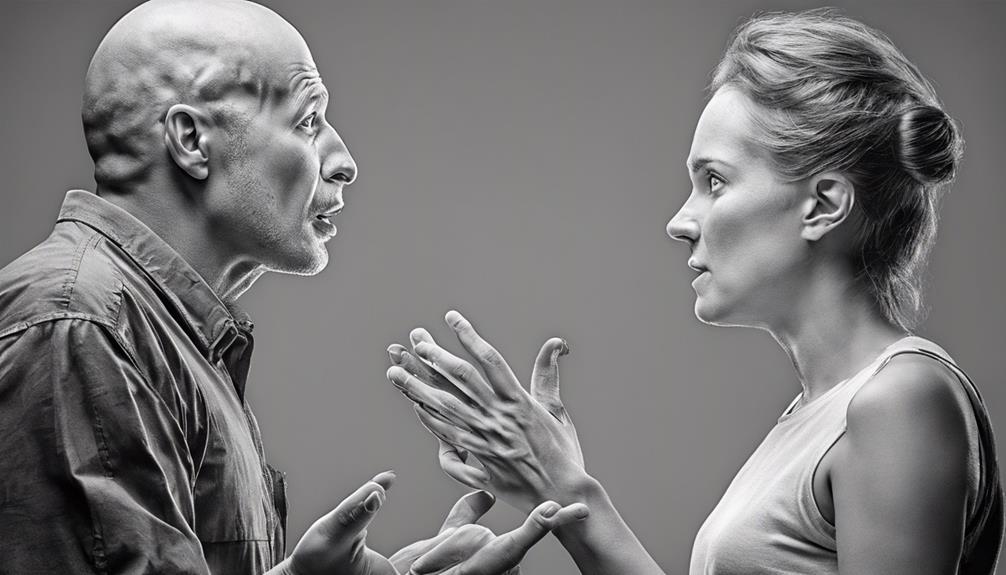
Disregarding a deaf person's preferred mode of communication not only hinders their understanding and participation but also demonstrates a lack of respect for their unique language and identity. When deaf people use sign language, it's crucial to recognize and honor this choice for effective interaction. Here are some reasons why respecting their preferred mode of communication is essential:
- Sign language is their primary means of communication: Deaf individuals rely on visual communication through sign language to express themselves effectively.
- Using verbal communication exclusively can be rude: Disregarding sign language in front of a deaf person can create barriers to understanding and hinder their active participation in conversations.
- Respecting their communication preferences fosters inclusivity: By honoring their choice of communication, we show respect for their identity and language.
- Avoiding sign language can make deaf individuals feel excluded: Failure to respect their preferred mode of communication can lead to feelings of isolation and exclusion.
Ignoring Deaf Culture and Etiquette
When we disregard visual cues and fail to respect the communication preferences of deaf individuals, we risk alienating them from the conversation.
It's crucial to recognize that ignoring Deaf culture and etiquette can lead to feelings of exclusion and disrespect.
Let's remember the importance of inclusivity and understanding in our interactions with the deaf community.
Disregarding Visual Cues
Neglecting visual cues when communicating with a deaf individual not only hinders understanding but also disrespects their cultural norms and preferred mode of interaction. Here are four reasons why disregarding visual cues is detrimental:
- Lack of Connection: Ignoring visual cues disconnects us from the rich tapestry of nonverbal information crucial for effective communication.
- Disrespect: Disregarding visual cues shows a lack of respect for the deaf person's cultural identity and preferred mode of interaction.
- Barriers to Understanding: Missing out on visual cues creates barriers to effective communication, hindering mutual understanding.
- Cultural Insensitivity: Failing to acknowledge visual cues can be perceived as dismissive of the deaf person's language and cultural heritage.
Lack of Respect
Addressing a deaf person without considering sign language preferences disregards their cultural identity and communication needs, demonstrating a lack of respect and understanding. It is crucial to honor their preferred mode of communication to show inclusivity and respect for their cultural background. By neglecting to utilize sign language, miscommunication can occur, leading to the deaf individual feeling marginalized and excluded. Deaf etiquette emphasizes the importance of inclusive communication methods, highlighting the significance of accommodating the needs of the deaf community. Engaging in verbal communication without regard for sign language not only showcases a lack of respect but also hinders effective and respectful interaction. Prioritizing inclusive communication is essential to fostering understanding and respect for individuals with different communication needs.
| Lack of Respect | Preferred Mode of Communication |
|---|---|
| Disregards cultural identity | Honors communication needs |
| Neglects deaf etiquette | Values inclusive communication |
| Leads to miscommunication | Prevents frustration |
Failing to Ensure Effective Communication
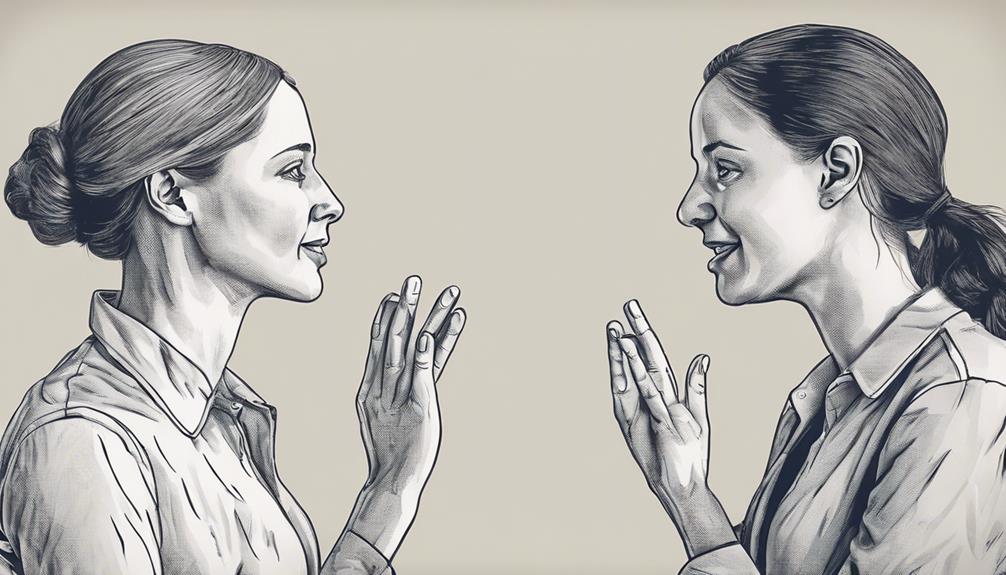
Unfortunately, overlooking the importance of using sign language when speaking in front of a deaf person can result in communication breakdowns and feelings of exclusion. Deaf individuals rely on visual communication, so not accommodating their needs can be disrespectful and frustrating.
Here are four reasons why failing to ensure effective communication with sign language is detrimental:
- Deaf individuals may feel isolated and left out of the conversation, impacting their sense of belonging.
- Misunderstandings can arise, leading to confusion and hindering the exchange of ideas.
- Without sign language, deaf individuals may struggle to express themselves fully, limiting their participation.
- Effective communication with sign language is essential for showing respect and consideration towards the deaf community, fostering inclusivity and understanding.
Sign Language as a Form of Respect

Sign language serves as a fundamental expression of respect towards deaf individuals, embodying inclusivity and understanding in communication. When we use sign language when interacting with a deaf person, we're showing that we value their communication needs and preferences. By not accommodating their preferred mode of communication, we inadvertently create a barrier to understanding and participation for the deaf individual. It's essential to recognize that spoken language alone can exclude deaf individuals from conversations, making them feel isolated and left out.
Using sign language demonstrates our respect for the language and culture of the deaf community. It shows that we're willing to make an effort to communicate in a way that's most effective and comfortable for them. By embracing sign language, we not only break down communication barriers but also foster a more inclusive and respectful environment for all individuals, regardless of their hearing abilities.
Impact of Inaccessible Communication on Deaf Individuals

When communication isn't accessible to deaf individuals, it creates barriers that prevent them from fully engaging and participating.
This lack of accessibility can lead to feelings of isolation and exclusion in social situations.
Providing accessible communication methods is crucial to ensure deaf individuals feel respected and included.
Communication Barriers for Deaf
Communication barriers for deaf individuals impact their daily interactions, leading to feelings of isolation and exclusion.
- Deaf person without sign language: Being excluded from conversations hinders their participation.
- Visual communication: Lack of sign language leads to misunderstandings and frustrations.
- Feeling of isolation: Not using sign language disregards their preferred mode of communication.
- Impact on effective communication: Essential information may be missed, affecting comprehension.
Understanding and addressing these communication barriers is crucial in fostering inclusivity and ensuring that deaf individuals can fully participate in interactions. By acknowledging their preferred mode of communication and actively working to include them, we can create a more accessible and supportive environment for all individuals, regardless of their hearing abilities.
Importance of Accessibility
Understanding the challenges faced by deaf individuals due to inaccessible communication highlights the critical need for prioritizing accessibility in all interactions.
Inaccessible communication not only excludes deaf individuals from active participation but also contributes to feelings of isolation and frustration.
Sign language plays a crucial role in breaking down these barriers and fostering inclusion.
By providing accessible communication methods, we can ensure that deaf individuals have equal opportunities to engage in discussions and access information.
Without such accommodations, deaf individuals may face obstacles in social interactions and overall engagement.
Prioritizing accessibility in communication is essential for creating a more inclusive environment where all individuals, including those who are deaf, can participate fully and feel valued.
Importance of Cultural Sensitivity and Inclusivity

In order to foster a truly inclusive environment, it's essential to prioritize cultural sensitivity when interacting with individuals from diverse backgrounds, including the deaf community.
Here are four key reasons why cultural sensitivity and inclusivity are crucial when communicating with deaf individuals:
- Respecting Preferred Mode of Communication: By using sign language, we honor the deaf person's choice of communication, showing respect for their cultural identity.
- Fostering Effective Communication: Embracing sign language promotes understanding and effective communication between hearing and deaf individuals, bridging potential communication gaps.
- Promoting Inclusivity: Using sign language in interactions with deaf individuals creates an inclusive environment where everyone feels valued and included.
- Demonstrating Mutual Respect: Prioritizing cultural sensitivity showcases mutual respect, acknowledging the richness of diversity and different communication needs within the deaf community.
Frequently Asked Questions
Why Is It Considered Rude to Speak in Front of Deaf People?
When we speak in front of deaf individuals without sign language, it can be seen as rude because it excludes them from understanding and participating in the conversation. This exclusion can make them feel isolated and disrespected, leading to frustration and misunderstandings.
Ignoring their preferred mode of communication hinders their ability to engage fully. It's important to be mindful of these factors to ensure inclusive and respectful communication.
What Are 2 Things Considered Rude by Deaf People?
When considering rudeness towards deaf individuals, two elements stand out: exclusion and ignorance. Excluding deaf people from conversations by not providing accessible communication methods like sign language can isolate them.
Ignorance of their preferred mode of communication overlooks their needs and can be disrespectful. Understanding and embracing accessible communication methods is crucial to showing consideration and inclusivity towards deaf individuals.
Which of the Following Is Considered Rude to Deaf People?
When speaking with a deaf person, it's crucial to consider their communication preferences. Not using sign language in this situation can be seen as disrespectful and exclusionary.
It's important to show respect by utilizing sign language, which allows for better understanding and inclusivity. By incorporating sign language into our interactions, we demonstrate consideration for the deaf person's needs and promote a more inclusive environment for everyone involved.
How Do Deaf People Talk to People Who Don T Know Sign Language?
When deaf individuals communicate with people who don't know sign language, they may use written messages, gestures, facial expressions, or speechreading. Some may seek help from family, friends, or interpreters. Technology like text messaging or communication apps can also aid in communication.
Additionally, carrying communication cards or using communication notebooks is common. Training programs and resources exist to teach basic sign language or communication strategies to improve interactions with deaf individuals.
Conclusion
In conclusion, speaking in front of a deaf person without considering their communication needs is like trying to navigate a dark room without a flashlight.
It's important to be mindful of how we communicate with others, especially those who may require different methods to fully engage in conversation.
By respecting and accommodating the needs of deaf individuals, we can create a more inclusive and understanding environment for everyone involved.
Let's strive to communicate effectively and thoughtfully with all.
Jamie is one of the creative forces behind the words that resonate with our audience at Deaf Vibes. With a passion for storytelling and advocacy, Jamie delves into topics that matter deeply to the deaf and hard-of-hearing community. Jamie’s articles are crafted with empathy, insight, and a commitment to positive change, from exploring the latest advancements in hearing technologies to shedding light on the everyday challenges and victories of those within the community. Jamie believes in the power of shared stories to inspire action, foster understanding, and create a more inclusive world for everyone.
Understanding Hearing Loss
How Windows High Volume Can Cause Hearing Loss: Tips to Protect Your Ears
Wander into the world of windows high volume and learn how it silently impacts your hearing health – the secrets to safeguarding your ears await!

Let’s be honest, the allure of blasting music through the windows is undeniable, but have you ever thought about the potential effects on our auditory health?
As we navigate through our daily lives, the constant exposure to loud noises can quietly take a toll on our ears without us even realizing it.
Understanding how this seemingly harmless habit can lead to potential hearing loss is crucial.
Stay tuned as we unravel the secrets of protecting our ears and discover practical tips to safeguard our auditory well-being in a world filled with noise.
Key Takeaways
- High volume from windows can damage hearing by harming delicate ear cells.
- Protect ears with earplugs or breaks to prevent irreversible auditory damage.
- Regular check-ups detect and prevent worsening hearing loss from high volumes.
- Be mindful of noise levels to avoid immediate and long-term hearing issues.
Understanding the Impact of High Volume
Exposure to high volume sounds can have detrimental effects on our hearing health, causing damage to the delicate hair cells in the ear and potentially leading to permanent hearing loss. Volume can cause Hearing.
The impact of high volume on hearing is profound and often underestimated. Prolonged exposure to loud noise, whether from music, machinery, or other sources, can result in irreversible damage to the auditory system. This damage primarily affects the hair cells in the cochlea, which are responsible for translating sound vibrations into electrical signals that the brain can interpret. When these hair cells are subjected to high volumes, they can become overworked and eventually die off, leading to hearing loss.
Additionally, exposure to loud noise can also trigger the development of tinnitus, a condition characterized by persistent ringing or buzzing in the ears. It's crucial to understand that even short bursts of high volume sounds, such as explosions or gunshots, can cause immediate and severe damage to our hearing.
Therefore, taking proactive measures to protect our ears from excessive noise exposure is essential for preserving our hearing health in the long term.
Common Symptoms of Hearing Damage
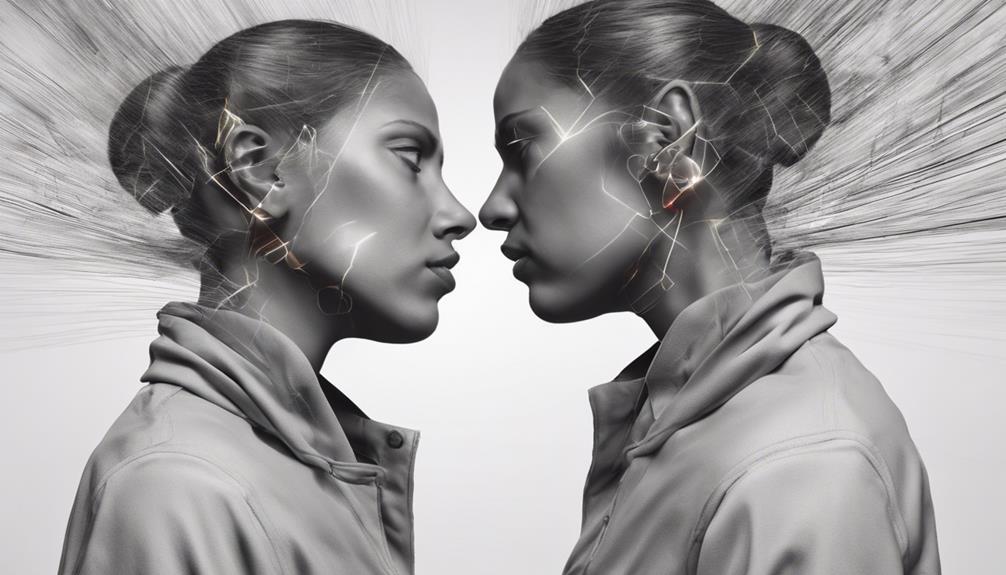
Indications of hearing damage commonly include persistent ringing in the ears, difficulty in understanding speech clearly, and a sense of sounds being muffled. Individuals with hearing damage may also exhibit sensitivity to loud noises and find it challenging to follow conversations in noisy environments. As part of ear protection, recognizing these symptoms early is crucial to prevent further damage and maintain overall hearing health. Below is a table summarizing common symptoms of hearing damage:
| Symptom | Description |
|---|---|
| Ringing in the ears (tinnitus) | Persistent noise or ringing sensation in one or both ears. |
| Difficulty understanding speech | Struggle to comprehend conversations, especially in noisy or crowded settings. |
| Muffled sounds | Sensation of sounds being unclear, dulled, or lacking sharpness. |
Being attentive to these signs and seeking professional evaluation promptly can aid in the management and prevention of hearing loss. Remember, early intervention plays a key role in protecting your ears and preserving your hearing abilities.
Risks of Prolonged Exposure
Continuously exposing oneself to high volume levels poses a significant risk to the delicate hair cells in the inner ear, potentially leading to irreversible damage and long-term hearing issues. High volume can cause various detrimental effects on hearing health, including:
- Development of Tinnitus: Prolonged exposure to high volume levels can result in the development of tinnitus, a condition characterized by a persistent ringing, buzzing, or hissing sound in the ears. This debilitating condition can significantly impact quality of life and may be challenging to manage.
- Noise-Induced Hearing Loss: High volume exposure is a common cause of noise-induced hearing loss, particularly in industries with high noise levels. This type of hearing loss is often gradual but can lead to permanent damage if preventive measures aren't taken.
- Immediate Auditory Damage: Even brief exposures to loud noise can cause immediate damage to the auditory system. This underscores the importance of protecting your ears from high volume levels to prevent both short-term and long-term consequences.
Effective Ways to Protect Your Ears

To safeguard our hearing health, implementing effective strategies to protect our ears is paramount in preventing potential damage from high volume exposure. Wearing earplugs or earmuffs in noisy environments significantly reduces the risk of hearing loss by acting as a barrier against loud sounds.
Taking regular breaks from prolonged exposure to loud noises allows your ears to recover and lowers the chances of overexposure. It's crucial to maintain safe volume levels when using headphones to prevent hearing damage. Opting for noise-canceling headphones can help reduce external noise, allowing you to listen at lower volumes without compromising sound quality.
Additionally, being mindful of noise levels in recreational activities like concerts can safeguard your ears from potential harm. By incorporating these practices into our daily routines, we can proactively protect our hearing and reduce the risk of hearing loss associated with high volume environments.
Importance of Regular Hearing Check-Ups
Regular monitoring of one's hearing health through routine check-ups is crucial for early detection and prevention of potential hearing loss. Here are three key reasons why regular hearing check-ups are essential:
- Early Detection: Regular check-ups can help identify early signs of hearing loss that may otherwise go unnoticed. Detecting hearing impairment in its initial stages allows for timely intervention and management strategies to be implemented.
- Assessment of Hearing Impairment: Hearing screenings conducted during check-ups can assess the extent of any existing hearing impairment. These assessments provide valuable information about the level of hearing loss and guide professionals in developing personalized treatment plans.
- Prevention of Deterioration: Early intervention through regular check-ups can prevent further deterioration of hearing. Monitoring changes in hearing health over time enables healthcare providers to intervene proactively and implement measures to preserve and protect the individual's hearing capabilities. Regular check-ups are, therefore, crucial for maintaining optimal ear health and overall well-being.
Frequently Asked Questions
Can Driving With the Windows Down Damage Your Hearing?
Yes, driving with the windows down can damage our hearing. Noise levels inside a car at highway speeds can exceed safe limits, leading to potential hearing loss over time.
It's essential to be cautious of this risk and take steps to protect our ears from prolonged exposure to loud wind noise while driving. Using ear protection like earplugs or noise-canceling headphones can help mitigate this danger and safeguard our hearing health.
How Do I Turn off Ear Protection in Windows?
Sure thing!
To turn off ear protection in Windows, right-click on the volume icon. Choose 'Sounds' then 'Playback' to find device settings. Double click on the playback device and uncheck the ear protection option. Apply the changes and test volume adjustments.
This simple process can help prevent sudden loud volume spikes that may cause hearing loss. Remember, always prioritize your ear health by taking such precautions.
How Can I Protect My Ears From Hearing Loss?
We can safeguard our hearing by using ear protection in loud environments, taking breaks from loud sounds, and maintaining safe volume levels with headphones.
Noise-canceling headphones can reduce the need for high volumes. Being aware of noise levels in activities like concerts is crucial for hearing health.
Regularly implementing these practices helps prevent damage to delicate ear structures and minimizes the risk of hearing loss.
How Can You Protect Yourself From Excessive Sound?
To protect ourselves from excessive sound, we must be vigilant about our surroundings and exposure to loud noises. Utilizing ear protection like earplugs or earmuffs, taking breaks from noisy environments, and maintaining safe volume levels with headphones are essential strategies. Noise-canceling headphones can also help reduce external noise, minimizing the need for high volumes.
Being mindful in recreational settings, like concerts, can prevent sudden exposure to damaging sound levels.
Conclusion
In conclusion, we must recognize the importance of protecting our ears from high volume to prevent hearing loss. By taking proactive measures such as using earplugs and maintaining safe volume levels, we can safeguard our hearing health.
Regular hearing check-ups are crucial to monitor any potential damage. Let's remember that our ears are delicate and valuable, and by prioritizing their protection, we can enjoy a lifetime of clear and healthy hearing.
Taylor brings a dynamic and analytical perspective to the Deaf Vibes team, focusing on research-driven content that educates and informs. With an unquenchable curiosity for new developments, policies, and social issues affecting the deaf and hard-of-hearing community, Taylor’s writing is a crucial resource for readers seeking to navigate these areas. Whether breaking down legal rights, highlighting educational opportunities, or offering guides on accessible technology, Taylor’s work is an invaluable asset to those seeking to empower themselves and others. Taylor’s commitment to accuracy and depth ensures that our readers have access to reliable and actionable information.
-

 Navigating the VA System1 month ago
Navigating the VA System1 month agoVA Hearing Loss Rating Chart: Understanding Disability Compensation
-

 Therapies and Interventions4 days ago
Therapies and Interventions4 days ago10 Auditory Processing Goals for Effective Speech Therapy
-

 Vetted1 month ago
Vetted1 month ago15 Best Oticon Hearing Aids to Improve Your Hearing in 2024
-

 Sign Language2 days ago
Sign Language2 days agoMastering the Art of Signing Letters in Sign Language
-

 Navigating the VA System4 weeks ago
Navigating the VA System4 weeks agoUnderstanding Bilateral Hearing Loss VA Rating Criteria
-

 Tinnitus1 month ago
Tinnitus1 month agoVA's Rating System for Tinnitus and Hearing Loss Explained
-

 Sign Language1 week ago
Sign Language1 week agoSign Language Emoji Translator: How to Communicate With Gestures
-

 Sign Language2 months ago
Sign Language2 months agoMedical Sign Language PDF: A Comprehensive How-To Guide


















